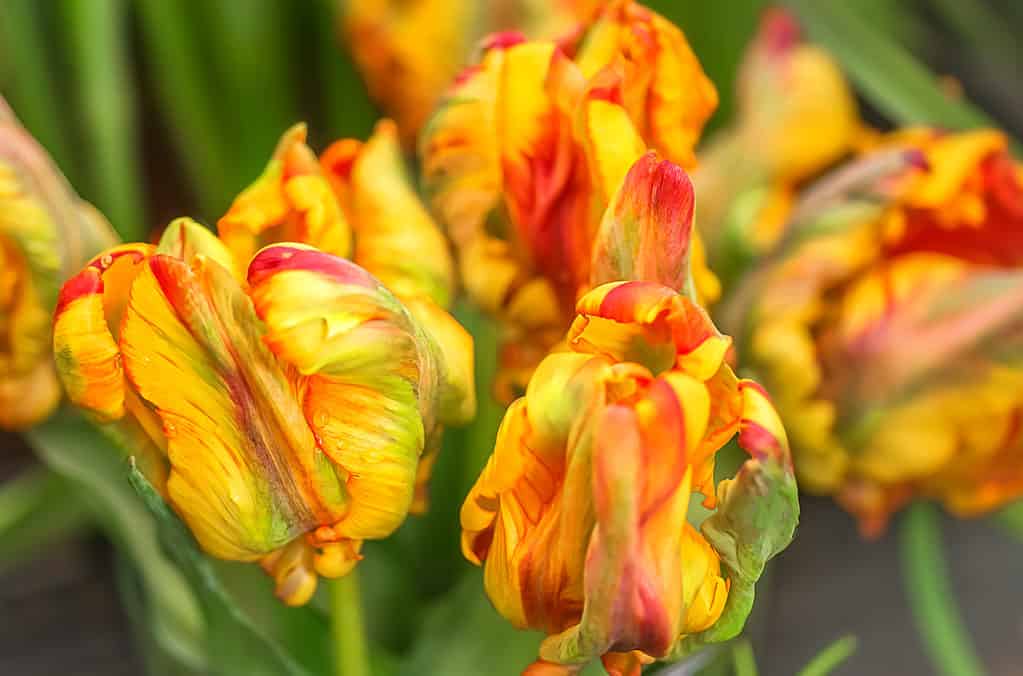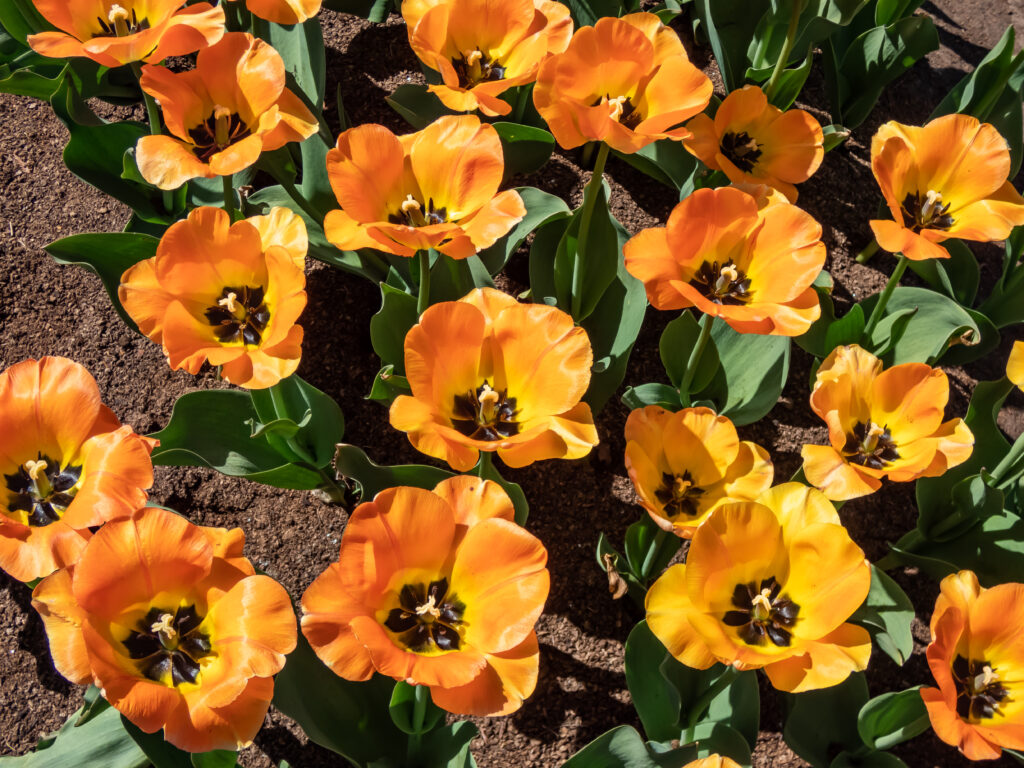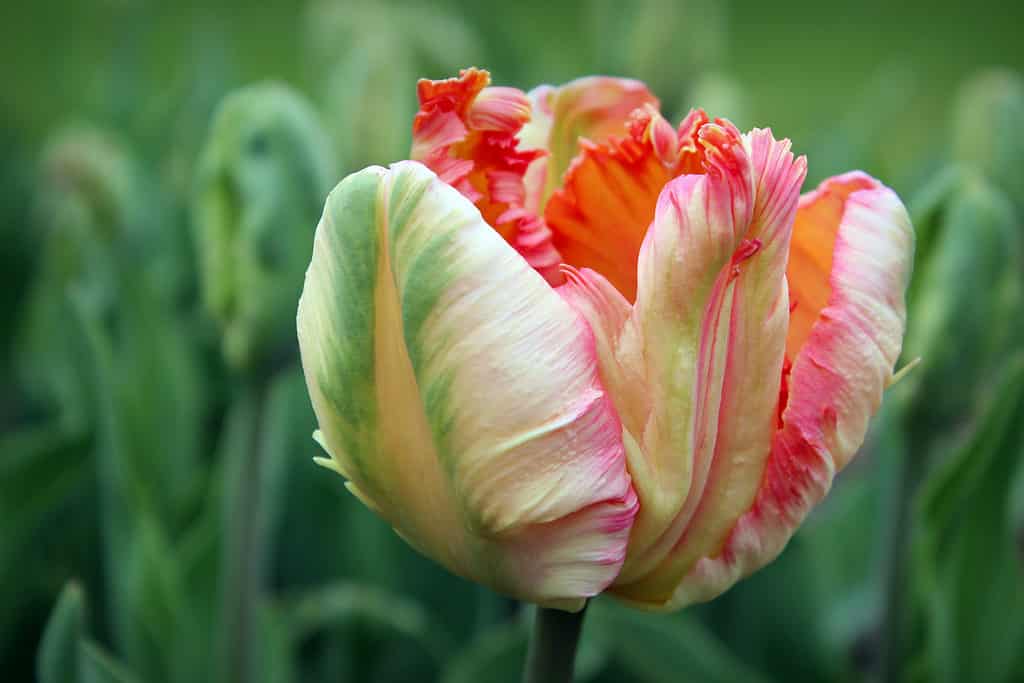Oregon is a Pacific Northwest state with a coastline that hugs the Pacific Ocean. It’s a land of dense evergreen forests, fertile valleys, wide-reaching plains and deserts dotted with majestic mountains. In this rich and varied landscape the tulip makes its incandescent spring appearance in the gardens of experts and novice growers alike.
Read on to discover which tulips thrive in Oregon, how to plant and care for them, along with the details of an Oregon tulip festival that draws visitors from near and far to feast their eyes on its fields of blooms!
3 Tulips Types that Thrive in Oregon

Although not native to Oregon, any tulip variety can thrive in any region of the state with the proper care and planning.
©Oxana Bazarova/Shutterstock.com
There are over 150 different species in the Tulipa genus and over 3,000 tulip varieties. These are divided into 15 types based on their flowers, heritage and blooming period. With so many to choose from you may be wondering, which tulips thrive in Oregon?
Although not native to Oregon, any tulip variety can thrive in any region of the state with the proper care and planning for the particular growing region. We’ll discuss 3 captivating classes of tulips that grow well in Oregon, explain their characteristics and give examples of some particular cultivars that stand out.
Darwin Hybrid Tulips
This group of tulip cultivars has a wide range of vibrant colors from white to yellow, orange, red and pink to brighten your Oregon landscape. Their flowers grow into the characteristic egg-shape of the classic tulip. They are a hardy tulip type with strong stems that grow 20-28 inches tall. These flowers are likely to withstand periods of heavy rain and strong winds and are a great choice for any region of Oregon. They are excellent for cutting and making stunning bouquets. As one of the most perennial hybrids, you can often coax these into several years of healthy blooms.
‘Daydream’ lives up to its name with some color-changing magic and a delightful fragrance. It opens yellow, fading to crimson edges and morphs to shades of apricot, and an orange or rosy glow. ‘Desert Sun’ stuns with the rich orange and golden yellow blending of its petals. A unique feature of these is the pyramid shape of their immature buds, which adds a unique twist to a bouquet.

The Darwin hybrid tulip ‘Daydream’ opens yellow, fading to crimson edges and morphs to shades of apricot, and an orange or rosy glow.
©iStock.com/Kristine Radkovska
Species Tulips
Species tulips are the variety that is unhybridized and grows best in conditions similar to those of the tulips’ origins. They like full sun and sandy or gravelly soil. These tulips tend to be much shorter than hybrids in stature but have other features to impress. They’ll often display multiple blooms per stem, expressive and variable foliage and will be most likely to perennialize. These make excellent additions to rock gardens and will do well in areas with cold winters.
The Turkestan Tulip (Tulipa turkestanica) is native to Central Asia. These tulips have white flowers with a hint of pink or yellow and a bright yellow center. They reach about 11 inches tall and flower from March to April. Tulipa orphanidea is a species found in Greece, Crete and Turkey that features orange, lily-shaped flowers and reach 9-11 inches tall. The Desert Tulip (Tulipa systola), the Late Tulip (Tulipa tarda) and the Garden Tulip (Tulipa acuminate) are other varieties to try.

Species tulips such as
Tulipa turkestanicaare much shorter than hybrids in stature but often display multiple blooms per stem.
©Mariola Anna S/Shutterstock.com
Parrot Tulips
Much like the bird of their namesake these are a flamboyant and feathery type. These tulips definitely stand out in a crowd with exceptionally bright petals that end with a fringe, or serrated edge. Their large, expressive blooms reach up to 5 inches across. Some might say the best comes last, as these are likely to be the last tulips blooming of the season. They certainly are a way to end the spring show!
‘Apricot Parrot’ features a kaleidoscopic display of apricot-orange with white and rose blendings and green highlights. ‘Silver Parrot’ has massive ruffled blooms of warm rose-pink and cream.

The parrot tulip ‘Apricot Parrot’ features a kaleidoscopic display of apricot-orange with white and rose blendings and green highlights.
©Joseph Skompski/Shutterstock.com
History of the Tulip
The original tulips were adapted to arid or semi-arid climates of central Asian landscapes. There they grew wild and returned year after year as perennial wildflowers. From these humble beginnings as blooms blessing the valleys, steppes and mountainsides, the tulip traveled to modern-day Turkey where it was planted in gardens and became a symbol of the Ottoman Empire. It became a symbol for power and wealth and was worn on the turbans of sultans. The word tulip is derived from the Persian word for turban, ‘tulipan’.
Guest of the one of the sultans of the Ottoman empire first planted the tulip in the Netherlands in 1593. The rarity of the tulip sparked “tulip mania” in Holland during the mid-1600’s, a frenzied market bubble and ultimate crash that has gone down in history. The Dutch learned that although a bulb that grows from seed takes 7-12 years to flower they could produce a flower the very next year from a bulb itself. The Dutch have cultivated tulips for centuries and the Netherlands are the largest producer of tulip bulbs today.
Are Tulips Annuals or Perennials?
Annual flowers spring up just once and die back in an ethereal moment of raw blooming beauty while perennials pop forth for years. So, are modern-day tulips perennial like their ancestors? It turns out that tulips are classified as a true perennial, but most cultivated varieties perform better as annuals.
Hybrid tulips are most common, as they come in such a rich array of shapes and hues. They usually bloom once in their full glory and then have reduced vigor and an exhausted display in future years. Most people choose to grow hybrids as annuals while others experiment with different bulbs and growing conditions to push tulips to perform year after year and spread about their garden.
When to Plant Tulips in Oregon
You’ll want to consider your growing region when determining when to plant tulip bulbs in Oregon. The USDA Hardiness Zones Map is a great resource to determine which zone your region falls under. Oregon has small pockets that fall within Zones 4-5, but the majority of that state is in Zones 6-9. The areas with the coldest annual temperatures fall in the middle and eastern two-thirds of the state, with the western third having warmer annual minimums.
Plant your tulip bulbs in the fall when soil temperatures are below 60 degrees Fahrenheit and 6-8 weeks before a big frost is expected in your area. The exact time will vary depending on the weather your region is experiencing in a given year. Planting time will generally come in October to November for Zones 4-7. For Zones 8-9 you’ll likely be planting from late November through early January.

Plant your tulip bulbs in the fall when soil temperatures are below 60 degrees Fahrenheit and 6-8 weeks before a big frost is expected in your area.
©Natallia Ustsinava/Shutterstock.com
Chilling Bulbs Before Planting for Warmer Climates
For Zones 8 and 9 in the western third of the state you’ll want to ensure your bulbs are properly chilled. Temperatures in these regions don’t drop low and long enough in the winter to initiate proper flower formation and root growth. Tulip bulbs require a period of 10-14 weeks at 35-45 degrees Fahrenheit.
To chill your bulbs, put them in your fridge in a ventilated bag or an egg carton stored separately from fruit. Ethylene gas is emitted as fruit ripens and will disrupt proper growth. If you start the chilling process in October they should be ready to plant from December to early January. Pull them from the fridge and plant immediately. In the warmest areas of Oregon you may want to pre-plant before moving your bulbs outdoors. Plant the bulbs in small pots and keep them cool and moist in the fridge for 4-6 weeks and plant when soil temperatures have dropped.
How to Grow Tulips that Thrive in Oregon
Tulips thrive when planted in areas of full sunlight but they can also do well in areas that are partially shaded. Plant your bulbs in well-draining soil, amended with peat moss, gravel or another organic additive if necessary to improve drainage. Dig a hole for each that is two to three times as deep as the bulb is tall. For most varieties this will be about 6-8 inches deep but for species varieties may be 4-5 inches. Space the bulbs 3-8 inches apart for the larger bulbs and 1-3 inches for smaller ones.
Mix in a low-nitrogen fertilizer when you plant the bulbs such as mature cow manure, aged compost or a bulb-specific commercial fertilizer. You can add a top dressing of fertilizer again in the spring. Cover the bulbs with soil and add a mulch layer of 2-3 inches to retain moisture and keep the bulbs cool. Water after planting and ensure that the area stays moist until spring for proper root development. Avoid overwatering, as fungal growth, rot or other problems can develop.
When Do Tulips Bloom?
Tulips bulbs emerge as radiant blooming flowers in the spring. While the climate of your region can somewhat affect bloom time, timing is largely dependent on the type of tulip bulb you plant. Darwin hybrid tulips will bloom mid-spring, Parrot tulips will usually make their appearance later in the spring and Species Tulips often bloom early-mid spring but can vary by species. Hybrid tulip blooms will be brilliant but ephemeral, lasting about 1-3 weeks. Species varieties may have blooms that last longer. You may want to plant a variety of bulbs with different bloom times to give your garden the best chance of a full-season tulip display.
Once the tulip cups begin their inevitable decline and begin to wilt you will want to clip the flower heads off of their stalks. Let the leaves continue to grow as the plant harnesses energy for another year. Once they are yellow and drooping completely, pull them off or clip them all the way back. Or, if you are treating your tulips as annuals, simply dig the bulbs up from the soil and compost them, leaving room for future varieties to be planted in their place.

Darwin hybrid tulips will bloom mid-spring.
©iStock.com/NVS
The Wooden Shoe Tulip Festival
The annual Wooden Shoe Tulip Festival in Woodburn, Oregon is a fantastic display of acres upon acres of tulips in-bloom. Hosted by the Wooden Shoe Tulip Farm, the festival runs at peak blooming times from mid-March through late April. A picturesque way to spend a spring day, wandering among the 40 acres of over 100 varieties of tulips. There are special wooden shoe making demonstrations, a craft market place, food vendors, children’s activities, photo opportunities and more!

The annual Wooden Shoe Tulip Festival in Woodburn, Oregon features over 100 varieties of tulips.
©Rick Obst / Flickr – License
Final Thoughts
We’ve covered everything that Oregon gardeners need to know for spring tulips that thrive in Oregon with radiant and healthy blooms. The 3 types we’ve outlined are just a few to get you started, but let your imagination run wild with any of the tulip types that you’re drawn to. Plant those unassuming bulbs in the chill of autumn, wait through a cold winter, and watch the magic as your hard work pays off in a display of shades, shapes and scents of spring.
The photo featured at the top of this post is © Printemps PhotoArt/Shutterstock.com
Thank you for reading! Have some feedback for us? Contact the AZ Animals editorial team.






